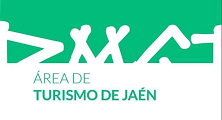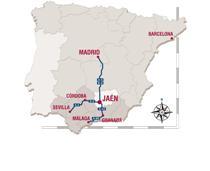Monographics - The Provincial Museum's Outstanding Pieces of art
The Museum in
ten pieces of work
Ten essential
pieces
in Jaén's Provincial
Museum
The museum contains two departments, archaeology and Fine Arts. The latter includes a great collection of prints. Nowadays, the museum houses 1691 pieces of work, it also has more than 2,500 items lent to other museums and more than 150,000 held in storage. In our brief tour through the museum we highlight ten essential pieces of work that you should not miss if you are visiting the Provincial Museum.
1
ANTHROPOMORPHIC IDOL
Origin: Marroquíes Altos, Jaén.
A Human-shaped statuette made up of two pieces that are joined in the centre by a tang. The statuette represents a standing male figure, his arms against his body and the legs close together. The head’s surface is almost rectangular, it decreases in the forehead and ends at the back, forming a right angle with the back part of the head. The face has three holes to represent the nose and two eyes, set in a single piece. The hair grows from the eyebrows and is divided into sections made by incisions and organized in a zigzagged pattern. The Idol has a kind of beard around the ears and the cheeks.
2
THE WARRIOR WITH DOUBLE ARMOUR
Origin:Cerrillo Blanco, Porcuna, Jaén.
It is an independent sculpture of a warrior, dressed in armour. Noteworthy is the peculiar helmet with metal reinforcements and the Iberian shield. This sculpture is part of the group of sculptures from Porcuna.
3
WOLF'S HEAD
Origin:Cortijo de “El Pajarillo”, Huelma, Jaén.
This piece represents a wolf with threatening behaviour, which we can deduce from the position of the ears, which are turned backwards, the snout, which is wrinkled, and the position of the mouth, which is half-open. This sculpture is part of a group of sculptures from the “Pajarillo”.
4
CHICLANA'S TREASURE
Origin: El Engarbo, Chiclana de Segura, Jaén.
This piece is part of the Ibero-Roman “Chiclana’s treasure”, made up of 61 silver pieces, including a bowl, vases and denarius coins. Two different scenes are represented: in the first, a rider appears upon a horse and, in front of him, a wild boar and a dog which runs in the opposite direction and turns the head towards the animal. In the second scene, we can see a female-shaped figure with her hands on her hips, dressed in a short skirt and two torques, lying on the back of the horseman, with two horses at the side.
5
TETHYS MOSAIC
Origin: Roman Villa Cortijo Puente de Armas, Bruñel, Quesada, Jaén.
Diamond shapes and knots trace a composition of rectangles and squares. In the centre we can find the face of Tethys framed by a frieze. We can see maritime motifs emerging from her hair, such as algae and crab claws, the symbols of this God of the Ocean; we can also see a snake wrapped around her neck.
6
PALEOCHRISTIAN SARCOPHAGUS
Origin: Molino del Rey, el Llanete, Martos, Jaén. 1975.
A sarcophagus decorated with columns containing seven niches. Only the lid of the sarcophagus is conserved to one third of the height of the original. It shows the miracles of God’s life, such as the denial of Saint Peter, the multiplication of the loaves of bread and fish and the wedding in Cana.
7
DIADEM
Molino del Rey, el Llanete, Martos, Jaén. 1975.
This piece is normally identified with a diadem, but it could also be a belt. The diadem is comprised of seven pieces, two of them are intentionally distal and the other five have a fake gem in molten glass. It is pentagonal shaped and is finished off with a welded hoop. All the plaques of the diadem are gold-plated and it has a hollow interior. This piece is part of the treasure found in Charilla, the ancient Islamic city of Sajral Walad.
8
SPRING IN COTE D'AZUR
José Nogué Massó (Sta. Coloma de Queral, Tarragona, 1880-Huelva, 1973). Oil painting on canvas.
It is a canvas painting representing a maritime landscape with a diagonal composition which balances the horizontal planes suggested by the sea and the sky. On the left we can observe a sample of trees of various species, the painter wanted to highlight the almond tree in blossom which is placed at the foreground.
9
MOTHERHOOD
Rafael Zabaleta Fuentes (Quesada, 1907-1960). Oil painting on canvas.
In the paintings by Zabaleta, the living beings and the Earth appear with the same intensity, he does not use matt inks and the shapes take a symmetrical design. In his works he usually represents, at least two different generations, as we can observe in Motherhood, where we can observe the distant resonances of the virgin and the child.
10
TRIBUTE TO EL GRECO
Manuel Ángeles Ortiz (Jaén, 1895-París, 1984). Oil painting on canvas.
Manuel Ángeles Ortiz praises adjective-free feelings, through the use of a plastic Cubist language, inherent to his circumstances as a Spanish artist in the School of Paris. So, this work is a great example of a perfect balance between emotions and feelings. We can observe the traces of the oriental soul that he had cultivated in Granada and which possibly inspired his praise towards El Greco, in his repeated series of art in the sixties and the seventies.

















